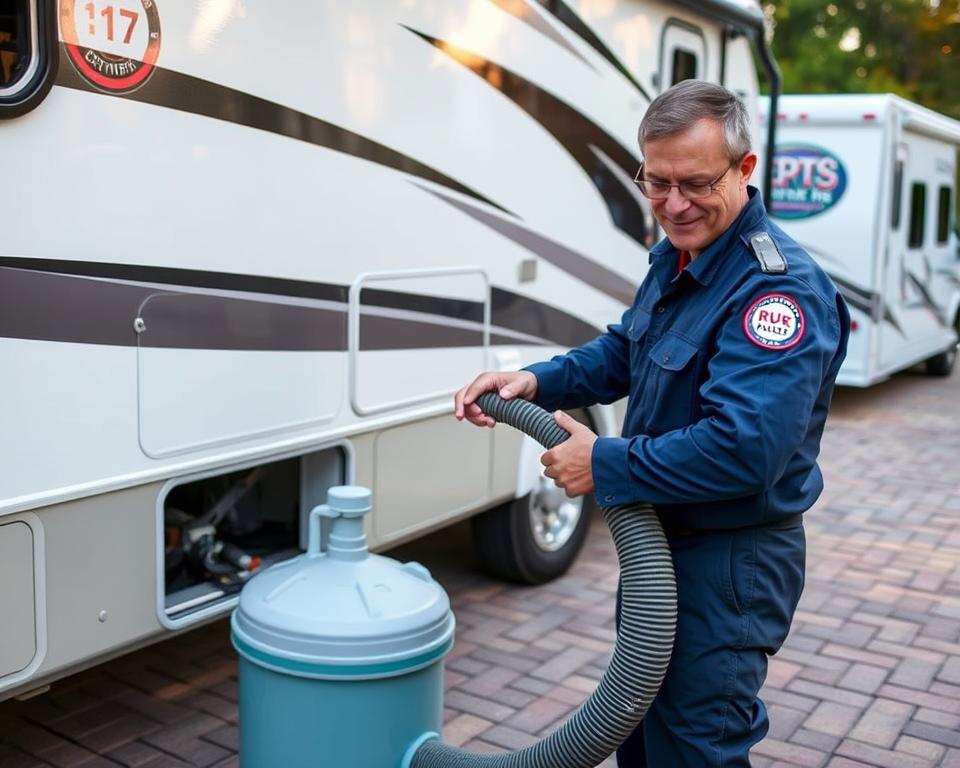RV Wastewater Pump Guide: Key Maintenance Advice
Did you ever ponder the operation of your camper’s waste disposal system? Being aware of the nuts and bolts of your camper sewer pump can avert mishaps, improving your camping trips. It’s centered on managing waste smoothly and steering clear of bad odors. With this manual, you’ll discover key maintenance methods for trailer septic tank pumping. All are designed to preserve your sewer network’s best operation.
Learning About Your Recreational Vehicle Sewage Pump Setup
The RV sewer pump system is essential for refuse disposal, making camp trips more comfortable. It consists of two key tanks: the sewage holding tank for solid waste and the sink/shower runoff tank for water from wash stations. Telling apart these tanks is important to prevent clogs and keep your RV running seamlessly.
An RV waste grinder is a favored option for sewage handling. It pulverizes solid waste into tiny bits, easing disposal. Alternatively, a traditional camper sewage pump is available. It smoothly moves waste without pulverizing, for those seeking a simpler option.
Knowing your RV’s sewage pumping system is crucial to preventing problems and ensuring trouble-free evaluations. Operating the system efficiently can prevent messes, uplifting your outdoor adventures.
Value of Regular Service
Caring for your RV sewer pump is imperative for a smooth travel experience. Without proper maintenance, you may experience odors, clogs, or backups. These glitches can mar your road trips.
Consistent servicing thwart such complications and extend your system’s life. By examining hoses and seals, you improve efficiency. A properly cared-for RV sewage pump ensures hygienic operation, letting you enjoy continuous journeys.
Consistent attention also results in financial savings over time. Oversight can cause costly breakdowns, requiring cost-intensive maintenance. Backing regular maintenance keeps your motorhome in peak form, saving money long term.
Recommended Frequency for RV Septic Tank Pumping
Understanding when to empty your RV Septic Tank is key for its upkeep. It’s advised to pump every 3–5 days during use. For brief excursions, post-trip emptying may suffice.
Interval depends on different variables. Tank size and frequency of use are key. Best practice is to pump when it reaches 66% capacity. This helps maintain smooth flow and ward off backups.
Tracking your RV Septic tank levels is key for a pleasant excursion. Handle your camper’s refuse to prevent issues while traveling.

Recommended Tank Emptying Tips
Properly emptying RV tanks is essential for your motorhome’s hygiene and reliability. Always empty first the black tank to let the grey water rinse leftover solids. This strategy avoids clogs and ensures smooth operation.
Opt for a durable waste hose for disposal. A robust hose ward off leaks and secures connections. Attach a tank rinser for a complete flush, using water pressure to remove lingering waste, boosting cleanliness.
Complete purging prevents residue buildup, stopping foul odors and potential issues. To maintain an efficient sewage system in your motorhome, observe these guidelines:
- Always add a tank treatment after emptying to manage smells and decompose waste.
- Keep an eye on fill levels to avoid overflow situations.
- Check your RV sewer pump often for clogs and wear.
- Deep rinse tanks each month or twice monthly, even during infrequent outings.
Adopting these techniques enhances your sewage system’s durability and efficiency, ensuring smooth journeys.
Preventing Odors and Clogs
For a memorable adventure, preventing foul aromas is key. Ensure tanks have sufficient water to aid in breaking down waste, warding off unpleasant odors. Also, choosing camper-safe TP helps prevent clogs, maintaining efficiency.
For enhanced refuse control in campers, try enzymatic solutions. These process sludge thoroughly, reducing effort. Ensure vent pipe clearance to keep air moving freely in the plumbing system.
Mindful disposal is vital to avoiding tank issues. Avoid flushing wipes, feminine products, and paper towels. These non-compostable materials can cause major clogs. Following these tips helps maintain a tidier camping environment.
RV Waste Pump Service Tips
Caring for your camper’s waste pump setup is key for hassle-free trips. Check valve seal integrity often to avoid drips. Faulty seals can cause accidents, harming your RV.
To eradicate odors and maintain cleanliness, sanitizing is key. Carry out intensive cleans quarterly to prevent buildup, ensuring the system performs reliably. These steps are critical for maintaining a on-board grinder, promoting durability and efficient operation.
Greasing valve components is another essential task. It helps stop leaks and boost functionality. Monitoring tank sensors is vital for accurate readings, preventing spillovers and unexpected pump issues. Regularly reviewing these points makes your RV adventures neater and more enjoyable.
Clues for Hiring a Professional Pump Service
Spotting sewage issues early can save you from bigger headaches. A primary clue you need a professional pump-out is delayed emptying. When sinks and toilets take longer to clear, it often points to blockages. It suggests your system may be full.
Persistent odors are another obvious clue of sewage troubles. Stench that won’t go away despite cleaning suggest trapped waste. It’s crucial to examine the elbow trap when dumping waste. Visible residue signals it’s time for pro maintenance.
Technicians employ water-jet systems to dismantle stubborn blockages efficiently. Ignoring these warnings can escalate into major problems. Therefore, it’s vital to seek help immediately when issues arise.
| Signs of Sewage Issues | Possible Action |
|---|---|
| Sluggish Emptying | Look for blockages; schedule pro maintenance |
| Persistent Odors | Check vents; contact pro service |
| Obvious Debris | Contact pump service for thorough cleaning |
Selecting the Ideal RV Waste Grinder
When selecting an RV macerator pump, assess its volume handling, durability, and compatibility with your RV’s size. A premium macerator is key for effective waste grinding. This is especially true for RVs requiring regular emptying. High-end pumps improve sewage handling, ensuring a more pleasant journey.
A range of options cater to specific demands. For an well-founded selection, focus on these main points:
- Capacity: Ensure the pump can handle your RV’s waste output.
- Durability: Select long-lasting equipment.
- Ease of Use: Prefer straightforward, easy-to-use models.
- Compatibility: Confirm it matches your fittings.
Carefully considering options when choosing an RV macerator pump boosts travel enjoyment and ensures efficient pump performance.
RV Sewer Pump Problem-Solving
Effective problem-solving for your RV sewer pump is vital in rectifying common sewage issues before they worsen. If you notice sluggish emptying, unplanned backflows, or persistent odors, act quickly. These are clear signs of malfunction requiring attention.
First inspect the pump, its connections, and hoses. Search for any clogs that could slow flow. Ensure inlet and outlet fittings are secure. Also, verify the pump’s power supply for reliable current.
If basic checks don’t detect the issue, note the pump’s sound. A unit that’s abnormally loud or unusually silent may have internal damage. Also, check for leaks, as these can compound sewage problems. With these troubleshooting steps, many RV owners identify and resolve issues early, avoiding costly repairs.
Ongoing Care for Your RV Pump
For long-term efficiency, commit to regular sewer pump upkeep. Sanitize the system consistently to prevent clogs. Set up and observe a maintenance routine, keeping everyone informed of their roles. This significantly increases your waste system’s lifespan.
Educating yourself and others on correct flushing habits is vital. This forestalls issues and fosters shared responsibility. The result benefits both users and the sewer system.
- Inspect plumbing and hoses periodically
- Maintain clear filter screens
- Arrange yearly pro maintenance
- Apply recommended conditioners
Sticking to these steps enhances your camper’s sewage system’s durability and keeps it healthy, making travels more comfortable.
Conclusion
Caring for your RV sewer system diligently is essential for smooth camping adventures. Regular attention to RV sewer system maintenance greatly minimizes problem risks, letting you engage in the journey. By knowing your system and applying reliable sewage methods, your trips will be free of waste management woes.
Using the critical tips from this guide improves RV waste management and enhances your travel comfort and safety. Maintain peak performance by following best upkeep practices and addressing potential issues promptly.
Keeping informed about your RV sewer system pays off. It guarantees homely comforts while exploring. Cheers to joyous and relaxed journeys!
Common Queries
When should I schedule RV Septic tank emptying?
Pump the RV Septic tank when it hits 66% capacity.
How do black and grey tanks differ?
Black tank is for sewage waste. Whereas, the grey tank collects water from basins and showers.
What is the recommended maintenance schedule for RV sewer pumps?
Inspect and sanitize system about every three months.
Recommended products for RV sewer pump maintenance?
Opt for biological tank additives.
How do I avoid clogs in my RV sewer system?
Use only RV-safe toilet paper.
What signs indicate I need professional RV pump-out?
Watch for slow drainage, recurring odors, or visible residue in the elbow.
Making your RV macerator pump work better?
Select a correctly sized pump for your RV.
Key inspection points for a thorough RV sewer cleanse?
Clean sensors and lubricate valves.
Guidelines for extended RV pump care?
Adopt regular deep cleans and consistent sanitation.
Septic pumping frequency for heavy RV use?
Empty every three to five days.


